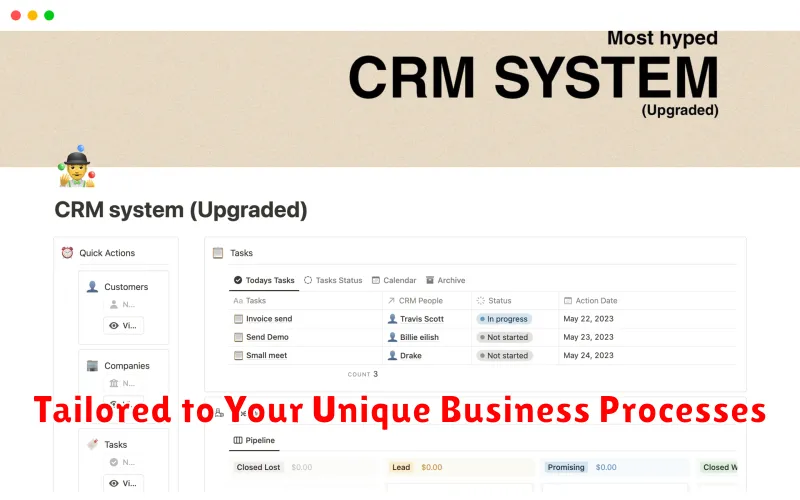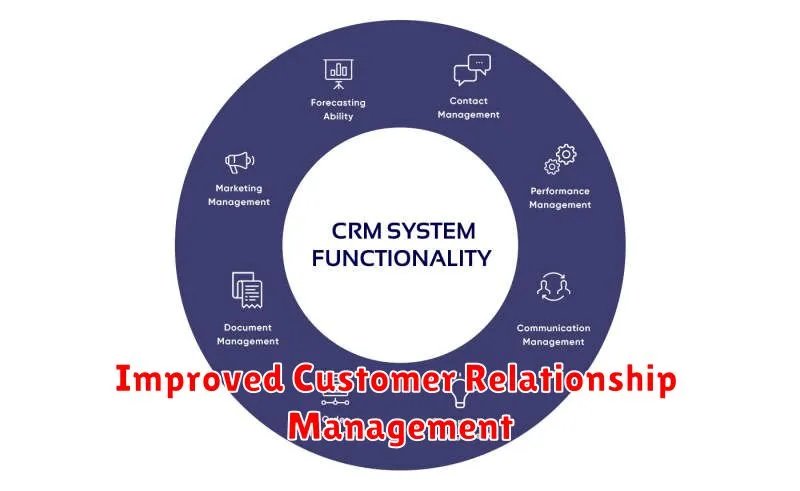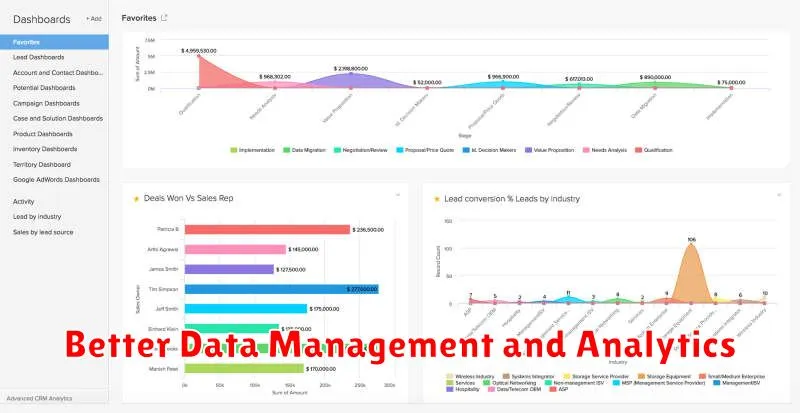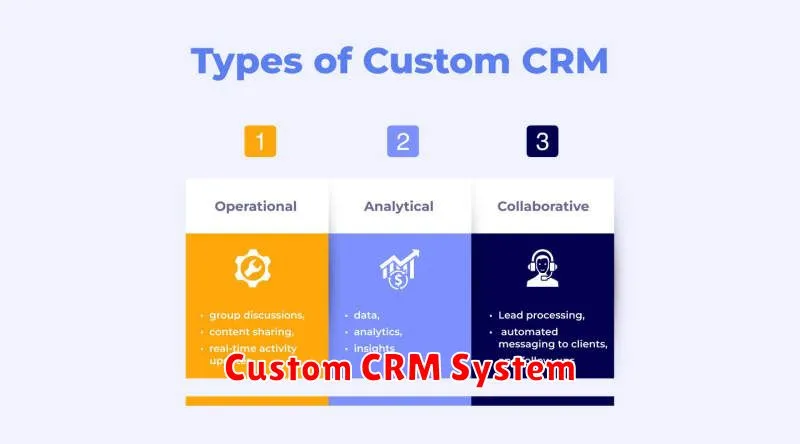Are you tired of juggling multiple spreadsheets and struggling to keep track of your customer data? It’s time to ditch the outdated methods and embrace the power of custom CRM software. A custom CRM, tailored to your specific business needs, can revolutionize your operations, boosting efficiency, improving customer relationships, and ultimately driving revenue growth. From streamlined sales processes to personalized marketing campaigns, a custom CRM empowers you to unlock the true potential of your customer base.
Understanding the Limitations of Generic CRM Solutions
In today’s business landscape, the importance of a robust Customer Relationship Management (CRM) system is undeniable. CRM solutions are designed to help businesses manage customer interactions, improve customer service, and ultimately drive sales. While there are numerous generic CRM solutions available, it’s crucial to understand their limitations to determine if they truly align with your specific needs.
Lack of Customization
Many generic CRM solutions offer a standardized set of features and functionalities, often lacking the flexibility to adapt to unique business processes. Customization may be limited to pre-defined options, which might not fully address your specific requirements. This can lead to inefficient workflows, wasted time, and frustration among users.
Integration Challenges
Businesses often operate with various existing systems, such as accounting software, marketing automation platforms, and email marketing tools. Generic CRM solutions might struggle to seamlessly integrate with these systems, leading to data silos and duplication of efforts. This can hinder data visibility and comprehensive reporting.
Limited Scalability
As your business grows, your CRM needs may evolve significantly. Generic solutions often struggle to scale effectively to accommodate increasing data volumes, complex workflows, and expanded user bases. This can result in performance issues, slow response times, and a frustrating user experience.
High Implementation Costs
While generic CRMs may seem affordable upfront, the implementation process can be costly and time-consuming. Customization, integration, and training all contribute to higher implementation costs. It’s essential to consider the overall cost of ownership, including ongoing maintenance and support.
When to Consider Generic CRM Solutions
Generic CRM solutions can be beneficial for businesses with simple requirements, limited budgets, and a desire for quick implementation. They may also suit small businesses or those in their early stages of growth.
Choosing the Right Solution
Before investing in a CRM solution, it’s crucial to carefully analyze your business needs, existing systems, and growth plans. Consider factors such as:
- Industry-specific requirements
- Data security and privacy concerns
- Scalability and future growth prospects
- Integration with existing systems
- User experience and ease of use
By carefully considering your needs and exploring various options, you can make an informed decision and choose a CRM solution that aligns with your specific requirements.
Tailored to Your Unique Business Processes

Our software is designed to seamlessly integrate with your existing systems and workflows. We understand that every business is unique, so we offer customizable solutions tailored to your specific needs.
Our team will work closely with you to understand your processes and develop a solution that meets your unique requirements.
Improved Customer Relationship Management

Customer relationship management is crucial for business success. By improving customer relationship management, businesses can build strong relationships with their customers.
Enhanced Sales and Marketing Automation

In today’s rapidly evolving business landscape, it is crucial for companies to embrace cutting-edge technologies to optimize their operations and achieve significant growth. One such technology that has revolutionized sales and marketing strategies is automation. By automating repetitive tasks and streamlining processes, businesses can free up valuable time and resources, enabling them to focus on more strategic initiatives.
Enhanced sales and marketing automation goes beyond basic automation, offering a wide range of functionalities to enhance efficiency and effectiveness. It involves leveraging advanced tools and platforms to automate complex tasks, such as:
- Lead generation and nurturing: Automating email campaigns, social media interactions, and website forms to capture and qualify leads.
- Sales forecasting and pipeline management: Utilizing predictive analytics and AI-powered insights to forecast sales performance and optimize pipeline management.
- Marketing campaign personalization: Personalizing marketing messages and offers based on customer behavior and preferences.
- Customer relationship management (CRM): Automating tasks such as scheduling appointments, sending reminders, and managing customer interactions.
By implementing enhanced sales and marketing automation, companies can experience numerous benefits, including:
- Increased productivity: Automating repetitive tasks frees up time for sales and marketing teams to focus on higher-value activities.
- Improved efficiency: Streamlined processes and automated workflows improve efficiency and reduce errors.
- Enhanced customer experience: Personalized interactions and timely responses enhance customer satisfaction and loyalty.
- Data-driven decision-making: Automation generates valuable data insights that enable better informed decision-making.
- Cost savings: Automating tasks reduces the need for manual labor, leading to cost savings.
However, it is important to note that automation is not a silver bullet. Successful implementation requires careful planning, strategic selection of tools, and ongoing optimization. Companies must ensure that their automation strategies align with their overall business objectives and address specific pain points. By leveraging the power of enhanced sales and marketing automation, businesses can gain a competitive edge, drive growth, and achieve their strategic goals.
Increased Efficiency and Productivity

The integration of artificial intelligence (AI) in the workplace has brought about a significant shift in how businesses operate, leading to increased efficiency and productivity. AI-powered tools and algorithms are transforming various aspects of business operations, from data analysis and customer service to automation and decision-making.
One key area where AI excels is in data analysis. AI algorithms can process vast amounts of data in real-time, identifying patterns, trends, and insights that would be impossible for humans to discern. This data-driven decision-making allows businesses to make more informed choices, optimize processes, and anticipate future needs.
Another significant impact of AI is on automation. Repetitive and mundane tasks can be automated, freeing up employees to focus on more strategic and creative work. AI-powered chatbots and virtual assistants can handle customer inquiries, while robotic process automation (RPA) can streamline administrative tasks. This automation not only improves efficiency but also reduces human error.
Furthermore, AI is revolutionizing customer service. AI-powered chatbots and virtual assistants can provide instant support and personalized experiences to customers. They can answer frequently asked questions, resolve simple issues, and even anticipate customer needs. This enhanced customer service leads to increased satisfaction and loyalty.
The integration of AI is also driving innovation. Businesses are leveraging AI to develop new products and services, optimize existing ones, and explore new markets. AI-powered research and development tools accelerate the innovation process and unlock new possibilities.
While there are concerns about job displacement, AI is ultimately creating new opportunities and roles. As AI automates certain tasks, it also necessitates new skills and expertise in areas like AI development, data science, and AI ethics. This shift in the workforce requires individuals to adapt and embrace new opportunities.
In conclusion, the integration of AI is driving a fundamental shift in the workplace, leading to increased efficiency and productivity. From data analysis and automation to customer service and innovation, AI is transforming businesses and paving the way for a more intelligent and efficient future.
Better Data Management and Analytics

In today’s data-driven world, effective data management and analytics are crucial for organizations to thrive. Organizations can gain valuable insights, make informed decisions, and improve their overall performance by leveraging data effectively. This article will explore key aspects of better data management and analytics, highlighting their importance and providing practical tips for implementation.
Importance of Data Management and Analytics
Data management and analytics play a vital role in various aspects of business operations, including:
- Customer Insights: Understanding customer behavior, preferences, and needs is essential for targeted marketing, personalized experiences, and improved customer satisfaction.
- Operational Efficiency: By analyzing data from various sources, organizations can identify bottlenecks, streamline processes, and optimize resource allocation.
- Risk Management: Data analytics helps in identifying potential risks, predicting future trends, and making proactive decisions to mitigate threats.
- Competitive Advantage: Companies that effectively leverage data can gain a competitive edge by developing innovative products and services, identifying market opportunities, and making strategic decisions.
Key Principles of Effective Data Management
Building a robust data management infrastructure requires adhering to several key principles:
- Data Quality: Ensuring data accuracy, completeness, and consistency is fundamental. Implementing data validation and quality control measures is essential.
- Data Security: Protecting sensitive data from unauthorized access, breaches, and misuse is paramount. Robust security protocols and encryption techniques should be employed.
- Data Governance: Establishing clear data ownership, access control policies, and data retention guidelines is crucial for compliance and accountability.
- Data Integration: Integrating data from multiple sources into a unified view provides a comprehensive understanding of business operations.
- Data Standardization: Adopting consistent data definitions, formats, and structures facilitates data analysis and reporting.
Advanced Analytics Techniques
Organizations are increasingly leveraging advanced analytics techniques to extract deeper insights from data. These techniques include:
- Predictive Analytics: Using historical data to predict future outcomes and trends, allowing for proactive decision-making.
- Machine Learning: Utilizing algorithms to identify patterns, make predictions, and automate tasks, enhancing efficiency and accuracy.
- Artificial Intelligence: Leveraging AI technologies to analyze large datasets, extract complex insights, and automate decision-making processes.
Benefits of Improved Data Management and Analytics
Implementing effective data management and analytics practices brings numerous benefits, including:
- Enhanced Decision-Making: Data-driven insights provide a solid foundation for better and more informed decisions.
- Increased Efficiency: Automating tasks and processes based on data analysis improves operational efficiency.
- Improved Customer Experience: Understanding customer needs and preferences allows for personalized experiences and enhanced satisfaction.
- Competitive Edge: Leveraging data to identify market trends and opportunities provides a competitive advantage.
- Increased Revenue: Data-driven insights can lead to increased revenue by identifying new markets, optimizing pricing, and improving sales strategies.
- Reduced Costs: Optimizing processes and eliminating inefficiencies can significantly reduce operational costs.
Conclusion
Data management and analytics are essential for organizations of all sizes to thrive in the digital age. By prioritizing data quality, security, and governance, and leveraging advanced analytics techniques, organizations can unlock valuable insights, improve decision-making, and achieve significant business outcomes.
Scalability and Flexibility

Scalability and flexibility are crucial aspects of software development, especially in today’s rapidly changing technological landscape. Scalability refers to the ability of a system to handle increasing workloads and user traffic without compromising performance. It’s essential for applications that need to grow and adapt to changing demands, such as social media platforms, e-commerce websites, and cloud-based services. Flexibility, on the other hand, emphasizes the adaptability of a system to meet evolving requirements and integrate with different technologies. A flexible system can be easily modified and extended without significant rework, ensuring its longevity and relevance in the long term.
Achieving both scalability and flexibility requires careful planning and design decisions. Here are some key considerations:
Architecture:
Choosing the right architecture is fundamental. Microservices architecture, for instance, promotes scalability by breaking down applications into smaller, independent services that can be scaled individually. Cloud-native architectures leverage cloud infrastructure to provide on-demand scalability and flexibility, allowing applications to adapt to fluctuating workloads and integrate seamlessly with other cloud services.
Technology:
Selecting the right technology stack plays a critical role. Containerization (Docker, Kubernetes) provides a lightweight and portable way to package and deploy applications, enhancing both scalability and flexibility. Serverless computing allows developers to focus on code without managing infrastructure, offering automatic scaling and cost optimization.
Development Practices:
Adopting agile development methodologies and embracing continuous integration/continuous delivery (CI/CD) pipelines foster flexibility by enabling rapid iteration and deployment of changes. Microservices architectures often benefit from CI/CD pipelines to streamline development and deployment of individual services.
Monitoring and Analytics:
Comprehensive monitoring and analytics are essential for identifying bottlenecks and performance issues, allowing for proactive adjustments and optimization to maintain scalability. Cloud-based monitoring tools can provide valuable insights into application behavior and resource usage, enabling informed decisions to enhance scalability and performance.
By prioritizing scalability and flexibility in software development, organizations can create systems that are robust, adaptable, and capable of meeting the ever-evolving demands of the modern world.
Competitive Advantage and Differentiation
In the dynamic and fiercely competitive business landscape, achieving sustainable success hinges on securing a competitive advantage. This refers to a distinct edge that sets a company apart from its rivals, enabling it to outperform them in the market. One of the key ways to achieve this advantage is through differentiation.
Differentiation involves creating a unique value proposition that resonates with customers and distinguishes a company’s offerings from those of its competitors. This can be achieved through various strategies, including:
- Product differentiation: Offering products with unique features, functionalities, or designs that cater to specific customer needs or desires.
- Service differentiation: Providing superior customer service, faster delivery times, or more personalized experiences.
- Price differentiation: Offering products or services at a lower price point or by implementing value-based pricing strategies.
- Brand differentiation: Cultivating a strong brand image, reputation, and customer loyalty.
- Channel differentiation: Utilizing innovative distribution channels or leveraging strategic partnerships.
By differentiating itself, a company can:
- Command premium pricing: Customers are willing to pay more for products or services that offer unique value.
- Increase customer loyalty: Differentiation creates a strong emotional connection with customers, making them more likely to repeat purchases.
- Reduce price sensitivity: When customers perceive a product or service as distinct and valuable, they become less price-sensitive.
- Attract new customers: Differentiation helps a company stand out from the competition and capture a wider market share.
- Enhance competitive advantage: Differentiation strengthens a company’s position in the market and makes it more difficult for competitors to imitate or challenge its offerings.
However, differentiation requires careful consideration and execution. Companies need to identify their target market, understand their needs and preferences, and develop a clear value proposition that resonates with them. They also need to ensure that their differentiation strategy is sustainable, scalable, and protected from imitation by competitors.
Ultimately, competitive advantage and differentiation are crucial for long-term success in today’s competitive marketplace. By strategically differentiating its offerings and creating a unique value proposition, a company can secure a distinct edge over its rivals and achieve sustainable growth and profitability.
Long-Term Cost Savings
Investing in sustainable practices can lead to significant long-term cost savings for businesses and individuals. This is because sustainable solutions often address underlying inefficiencies and reduce reliance on expensive resources.
For example, implementing energy-efficient technologies such as LED lighting and solar panels can dramatically reduce electricity bills. Similarly, water conservation measures like low-flow fixtures and rainwater harvesting can significantly lower water usage costs.
Beyond immediate cost savings, sustainable practices also contribute to a more resilient and adaptable future. By reducing reliance on finite resources, we can better withstand fluctuations in price and supply.
Furthermore, sustainable businesses are often seen as more ethical and responsible, attracting customers and investors who prioritize environmental and social impact.
In conclusion, investing in sustainable practices is not just about saving the planet, but also about saving money in the long run. By embracing sustainability, businesses and individuals can create a more prosperous and sustainable future for all.
